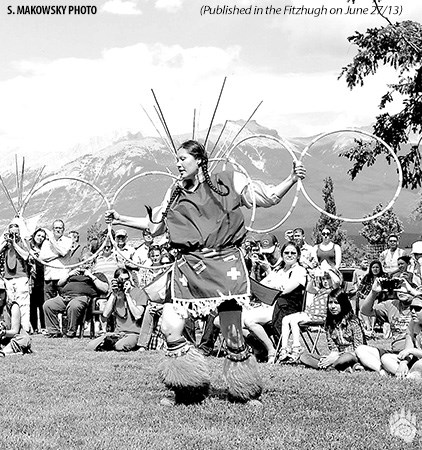 Last weekend’s Aboriginal Day festivities attracted a diverse crowd, including travellers from as far away as Scotland and Australia, to help celebrate First Nations tradition and culture.
Last weekend’s Aboriginal Day festivities attracted a diverse crowd, including travellers from as far away as Scotland and Australia, to help celebrate First Nations tradition and culture.
“Multiculturalism is alive and well here [in Jasper],” said Sucker Creek First Nation council member Terry Calliou, after asking where everyone in the crowd was from.
Sucker Creek First Nation, which is one of more than 20 Aboriginal communities with historic ties to Jasper National Park, was chosen to share its Cree heritage during this year’s Aboriginal Day celebrations. Each year a different community has the opportunity to help host Aboriginal Day in the park.
“[First Nations] heritage and culture are strong foundations on which to build the future of Canada,” said JNP Supt. Greg Fenton.
There was live entertainment with singers, drummers and dancers, and the crowd even joined in for a few traditional round dances. Artisans also displayed their artwork, crafts and food, including fresh bannock.
Those celebrating Aboriginal Day with Parks Canada and Sucker Creek First Nation witnessed an event that doesn’t happen often. In honour of his journey and contributions as a leader, Chief Jim Badger was presented with a traditional headdress.
The elaborate headdress featured all the colours of the rainbow, which represent earth, fire, air and water. The headdress is also made up of eagle feathers, which is a First Nations symbol for the thunderbird, a mythic creature that represents power and strength.
“The thunderbird is one of the greatest allies and teachers,” explained Fred Campiou, who led the ceremony and blessed the headdress before he placed it on Badger’s head.
Aside from honouring tradition, Aboriginal Day serves as a time to realize the struggle many First Nations have faced throughout history, and still face today, said Rose Laboucan, chief of Driftpile First Nation and the only female chief in Treaty 8.
“It isn’t as if we come here with a clean slate,” she said.
In particular, she addressed a recent study released by The Canadian Centre for Policy Alternatives and Save the Children Canada that states that 50 per cent of Canada’s status First Nations children live in poverty.
“There is no need for First Nations to have that high level of poverty,” she said. “We can make a difference and move forward together.”
Campiou perhaps put it best when he said: “Love one another because you’re not always going to be here.”
After events on the Visitor Information Centre Lawn, the public was invited to continue the celebration with Sucker Creek First Nation at the newly opened Aboriginal Cultural Area between Fifth and Sixth bridges. There was also a presentation at the Whistlers Campground Outdoor Theatre.
